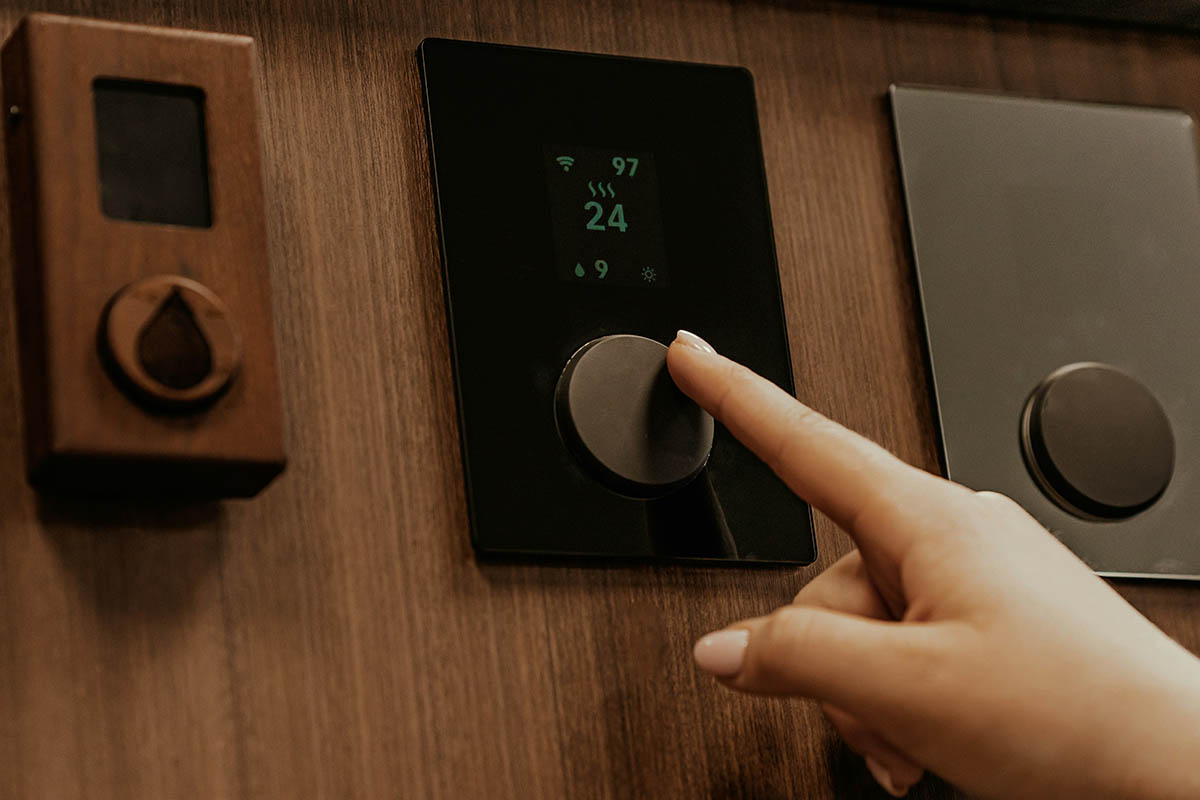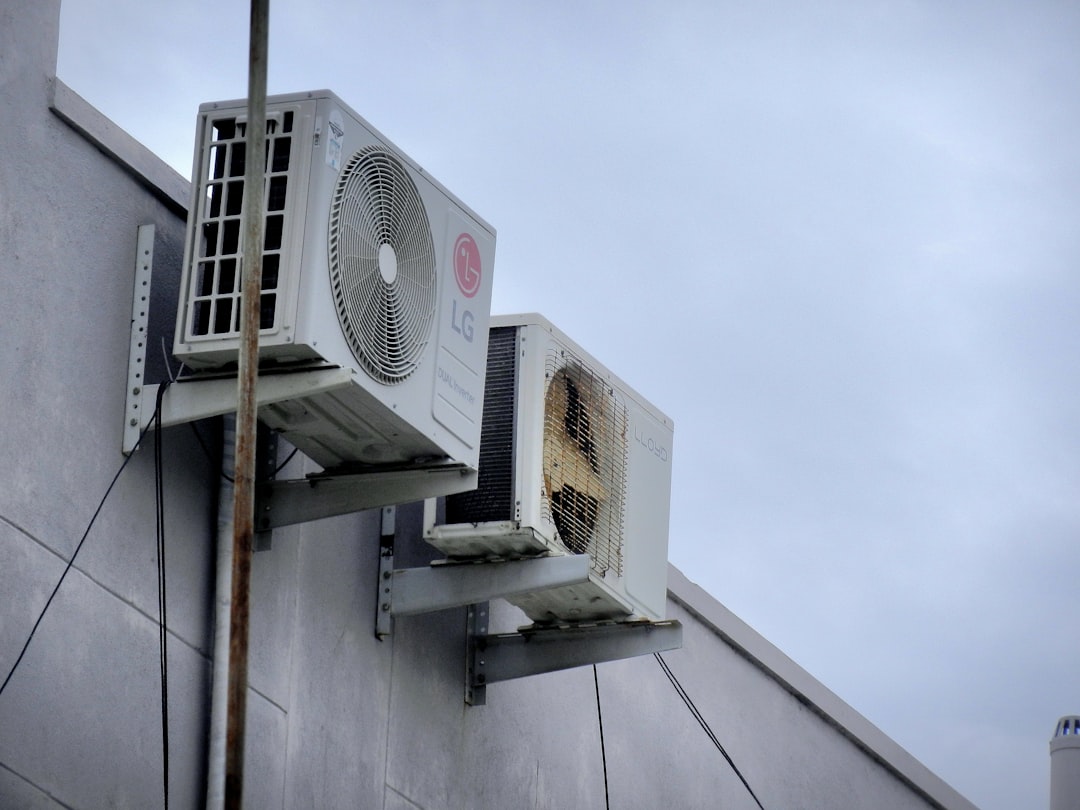
Home Air Conditioner Buying Guide: Stay Cool, Stay Happy
Why Choosing the Right Home Air Conditioner Matters
A home air conditioner is more than just a luxury—it's essential for comfort and health during Utah's hot summers. Here are the main types to consider:
Central Air Conditioners
- Cool entire home through existing ductwork
- Most efficient for larger homes
- Consistent temperature throughout
Ductless Mini-Split Systems
- No ductwork required
- Zone cooling for individual rooms
- Highest energy efficiency ratings
Window/Wall Units
- Single-room cooling solution
- Lower upfront cost
- Easy installation
Portable Units
- Movable between rooms
- Temporary cooling option
- Less efficient overall
Whether you're dealing with temperature inconsistencies in your two-story home, looking for a quiet solution for your condo, or wanting to upgrade an older system, the right air conditioner can slash your energy bills while keeping your family comfortable. ENERGY STAR certified central air conditioners use at least 10% less energy than standard models, and proper sizing is crucial—too small won't cool effectively, while too large wastes energy and creates humidity problems.
I'm Alex Wiltz, founder of Air Pros Utah Heating & Cooling, and I've been working with home air conditioner systems since high school through specialized HVAC training. My years of hands-on experience with Utah's unique climate challenges have taught me that the right cooling system makes all the difference in your comfort and energy costs.
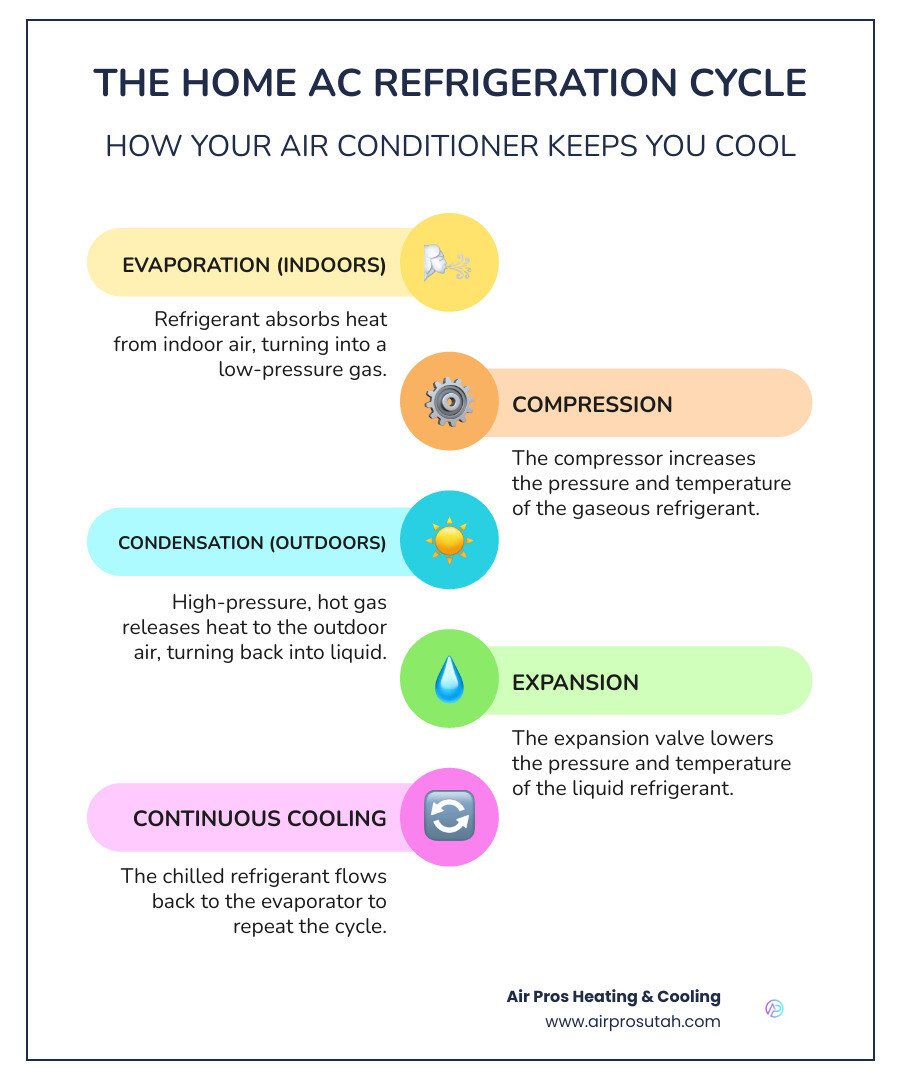
Home air conditioner terms made easy:
Understanding the Different Types of Air Conditioners
When summer hits Utah, you need a cooling solution that works for your specific situation. The good news? There are several excellent home air conditioner options, each designed for different homes, budgets, and comfort needs. Let's walk through your choices so you can find the perfect fit.
Whether you're cooling a sprawling family home or just need relief in your bedroom, understanding whole-home versus room-by-room cooling will help guide your decision. For a comprehensive look at how different systems handle Utah's unique climate challenges, check out our Beat the Utah Heat AC Systems Guide.
Central Air Conditioners
Think of central air as the gold standard for whole-home cooling. These split systems work beautifully with your existing ductwork, using an outdoor unit (with the compressor) and an indoor unit (the evaporator coil) to keep your entire home at a consistent, comfortable temperature.
Here's how the magic happens: When your thermostat calls for cooling, the outdoor unit kicks in and refrigerant starts circulating between the indoor and outdoor coils. The evaporator coil absorbs heat from your home's air, while a blower pushes this newly cooled air through your ductwork to every room. Meanwhile, the outdoor unit releases all that captured heat outside.
Central air conditioners are ideal for larger homes with existing ducts. They come in sizes ranging from 1.5 to 5 tons, so there's a perfect match for your square footage. One thing that surprises many homeowners: your central AC doesn't actually pull in outside air. Instead, it conditions and recirculates the air already in your home, filtering it as it goes.
Ductless Mini-Split Systems
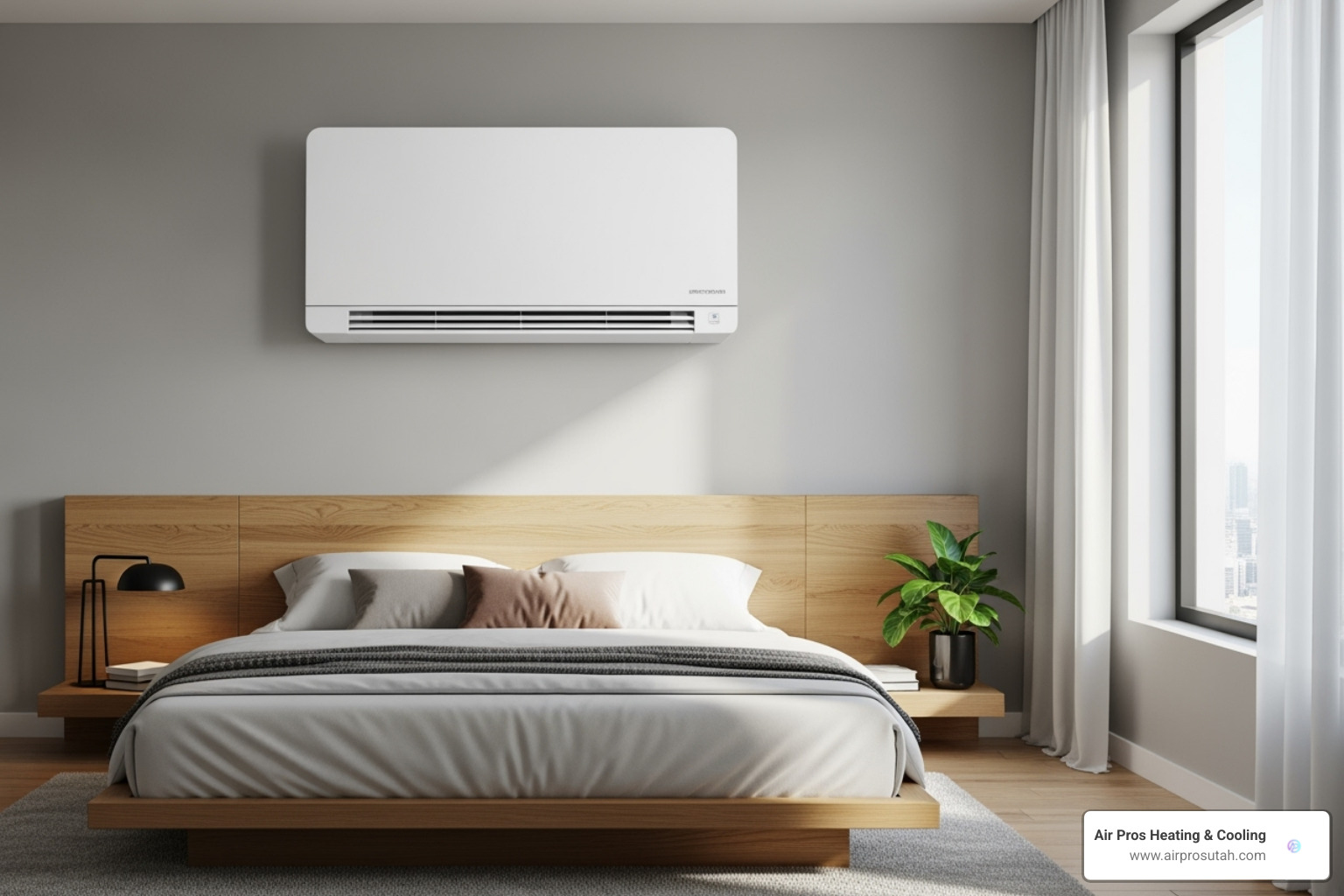
If you love the idea of personalized room-by-room comfort, ductless mini-splits might be your perfect match. These innovative systems offer zoned cooling, meaning you can set your bedroom to a cool 68°F while keeping the guest room at 75°F. Talk about customized comfort!
No ductwork required makes these systems incredibly versatile. A small conduit connects the outdoor compressor to one or more indoor units mounted on your walls. Installation is less invasive than central air, and you won't lose energy through leaky ducts.
The high energy efficiency of mini-splits really shines because they deliver cooling directly where you need it. No energy gets lost traveling through ductwork, which means lower bills for you. At Air Pros, we specialize in these versatile systems because they offer such personalized comfort solutions for Utah families. Learn more about various cooling options on our Air Conditioning Heating Units page.
Window and Wall-Mounted Units
Sometimes you just need to cool one room, and that's where window and wall units shine. These single-room solutions offer a lower upfront cost and easy installation, especially for window units.
Window units fit right into your window frame, straddling indoor and outdoor air. They're perfect for apartments or if you're renting and need a temporary solution. The downside? They can obstruct your window view and aren't exactly winning any beauty contests.
Wall-mounted units require cutting through your wall but offer a more permanent, aesthetically pleasing solution. They're typically quieter than window units thanks to better insulation from their fixed installation. While window units are easier to maintain yourself, wall units might need professional help for repairs.
Portable Air Conditioners
Portable air conditioners are the ultimate flexible cooling solution. These movable units can follow you from room to room, venting hot air through a hose connected to your window. They're fantastic for dorm rooms, home offices, or when you need temporary cooling while your main system gets repaired.
The trade-off for all that convenience? Portable units are less efficient than other types. They work great as a backup or for specific situations, but if you're looking for consistent, energy-efficient cooling for larger spaces, you'll probably want to consider other options.
Key Factors for Choosing Your Perfect Home Air Conditioner
Finding the perfect home air conditioner is like shopping for a car—you wouldn't buy one without considering your family size, budget, and how you'll actually use it. The same thoughtful approach applies to cooling your home. Let's walk through the key factors that will help you make the smartest choice for your comfort and wallet. When you're ready to move forward, our team specializes in expert Air Conditioning Installation Salt Lake City UT.
Sizing Your Unit Correctly (BTUs & Tonnage)
Here's the thing about air conditioner sizing—it's not a guessing game, and bigger isn't always better. Your home air conditioner's cooling power is measured in British Thermal Units (BTUs), and for larger systems, we talk about tonnage. One ton equals 12,000 BTUs per hour, which might sound like a lot, but it's actually the amount of cooling you'd get from melting one ton of ice in 24 hours.
Getting the size wrong can cause real problems. An oversized unit creates what we call "short cycling"—it cools your space too quickly, shuts off, then kicks back on again shortly after. Think of it like a sprinter trying to run a marathon by doing repeated 100-yard dashes. It's exhausting for the equipment and wastes energy. Plus, the unit won't run long enough to remove humidity, leaving your home feeling uncomfortably sticky.
An undersized unit faces the opposite problem—it runs constantly without ever reaching your target temperature. It's like asking a small car to tow a heavy trailer uphill; it'll try its best but struggle the whole way, wearing out much faster than it should.
Proper sizing considers much more than square footage. While you might hear rules like "one ton per 1,000 square feet," that's just a starting point. We also look at your home's insulation quality, window size and efficiency, ceiling height, local climate conditions here in the Salt Lake City Valley, and even which direction your home faces. That's why we always recommend a professional assessment—your home is unique, and your cooling system should be sized accordingly.
Understanding Energy Efficiency: SEER & ENERGY STAR
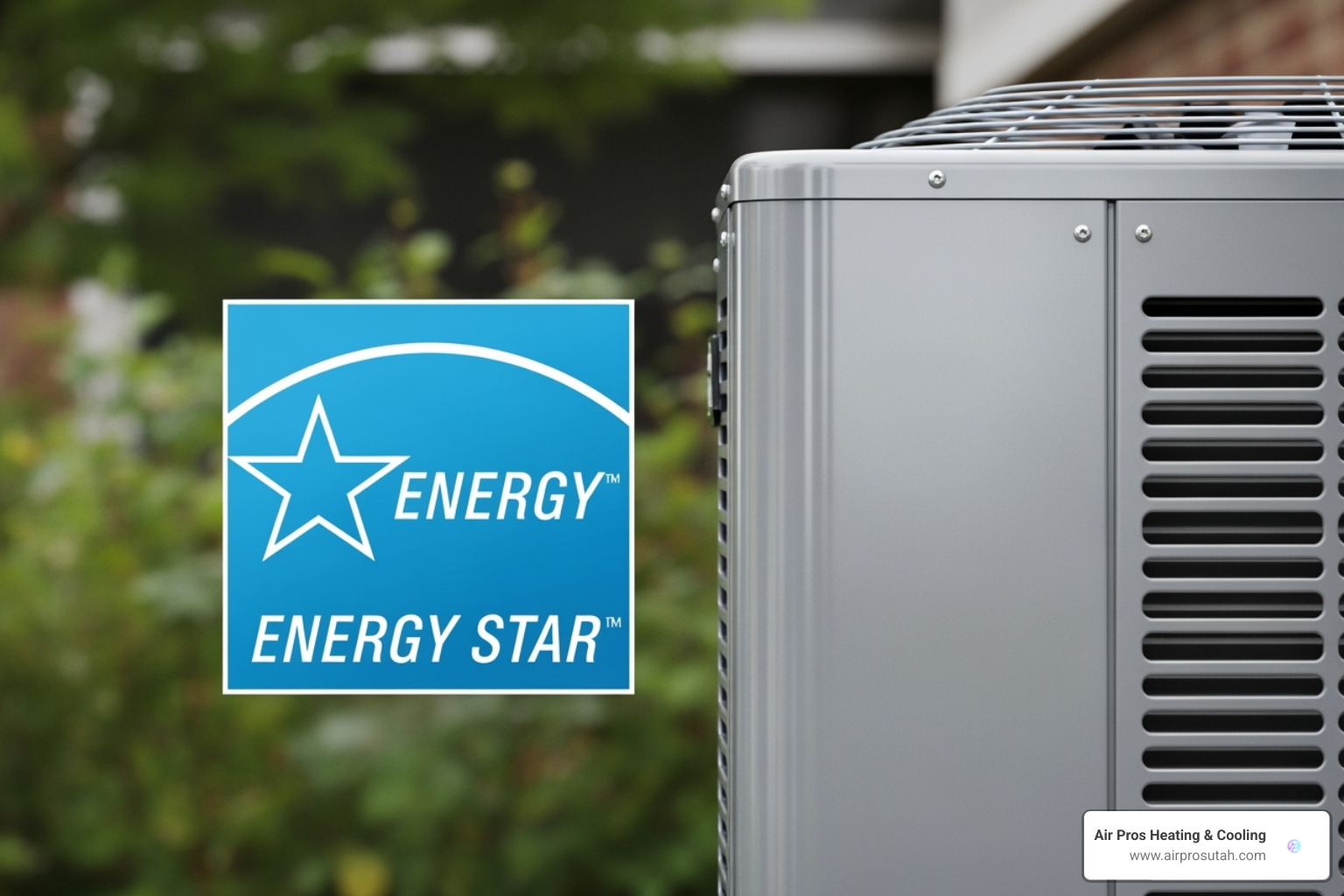
Energy efficiency might sound technical, but it's really about keeping more money in your pocket while staying comfortable. The SEER rating (Seasonal Energy Efficiency Ratio) is your best friend here. This number tells you how much cooling you get for every dollar of electricity you spend over an entire cooling season. The Seasonal energy efficiency ratio (SEER) works like a car's miles-per-gallon rating—higher numbers mean better efficiency.
Today's air conditioners range from SEER 13 to 21 or higher. Moving from a SEER 10 unit (common in older homes) to a SEER 16 unit can cut your cooling costs nearly in half. That's real money back in your pocket every summer.
ENERGY STAR certification takes efficiency even further. These units use at least 10% less energy than standard new models, and they've been independently tested to ensure they deliver on their promises. When we help customers choose systems, we often guide them toward ENERGY STAR models because the energy savings add up quickly. You can explore more about these efficient options in our Energy Efficient Air Conditioner guide.
The savings really add up over time. A high-efficiency home air conditioner might cost more upfront, but it typically pays for itself through lower energy bills within a few years, then continues saving you money for the rest of its 15-20 year lifespan.
Modern Features and Innovations
Today's home air conditioner systems are incredibly smart compared to the basic units from even just a decade ago. Smart thermostats let you control your cooling from anywhere using your phone, and they can learn your schedule to automatically adjust temperatures when you're away. Some customers tell us they love arriving home to a perfectly cool house without having wasted energy all day.
Variable-speed compressors are game-changers for comfort. Instead of the old on-off approach, these systems can dial their output up or down to match exactly what your home needs. This means more consistent temperatures, better humidity control, and quieter operation. It's like having cruise control for your home's comfort.
Modern units are also remarkably quiet. Advanced fan designs and sound-dampening materials mean you'll barely notice when your system is running. Wi-Fi connectivity allows remote monitoring and control, while advanced refrigerants like R-32 offer better environmental performance than older options.
These innovations aren't just bells and whistles—they translate into real benefits like lower energy bills, better comfort, and peace of mind knowing your system is running efficiently.
Keeping Your System in Peak Condition
Your home air conditioner is like a faithful friend who works hard all summer long. Just like any good friendship, it needs a little attention and care to keep things running smoothly. The good news? Most of what your AC needs is pretty simple stuff you can handle yourself, plus an occasional check-up from the pros.
Think of maintenance as an investment rather than a chore. A well-maintained system doesn't just avoid those dreaded midnight breakdowns when it's 95 degrees outside—it also runs more efficiently, keeps your energy bills reasonable, and can last years longer than a neglected unit. When you do need professional help, our team is ready with Air Conditioner Repair Salt Lake City services.
Essential Air Conditioner Maintenance
Here's the thing about AC maintenance: it's not rocket science, but it makes a world of difference. Your home air conditioner has a few basic needs, and meeting them will keep you cool and comfortable all season long.
Changing filters regularly is hands-down the most important thing you can do for your system. I can't tell you how many service calls we get that could have been avoided with a clean filter. When your filter gets clogged with dust, pet hair, and everyday household particles, your AC has to work like it's breathing through a straw. This makes it work harder, use more energy, and can even cause the coils to freeze up.
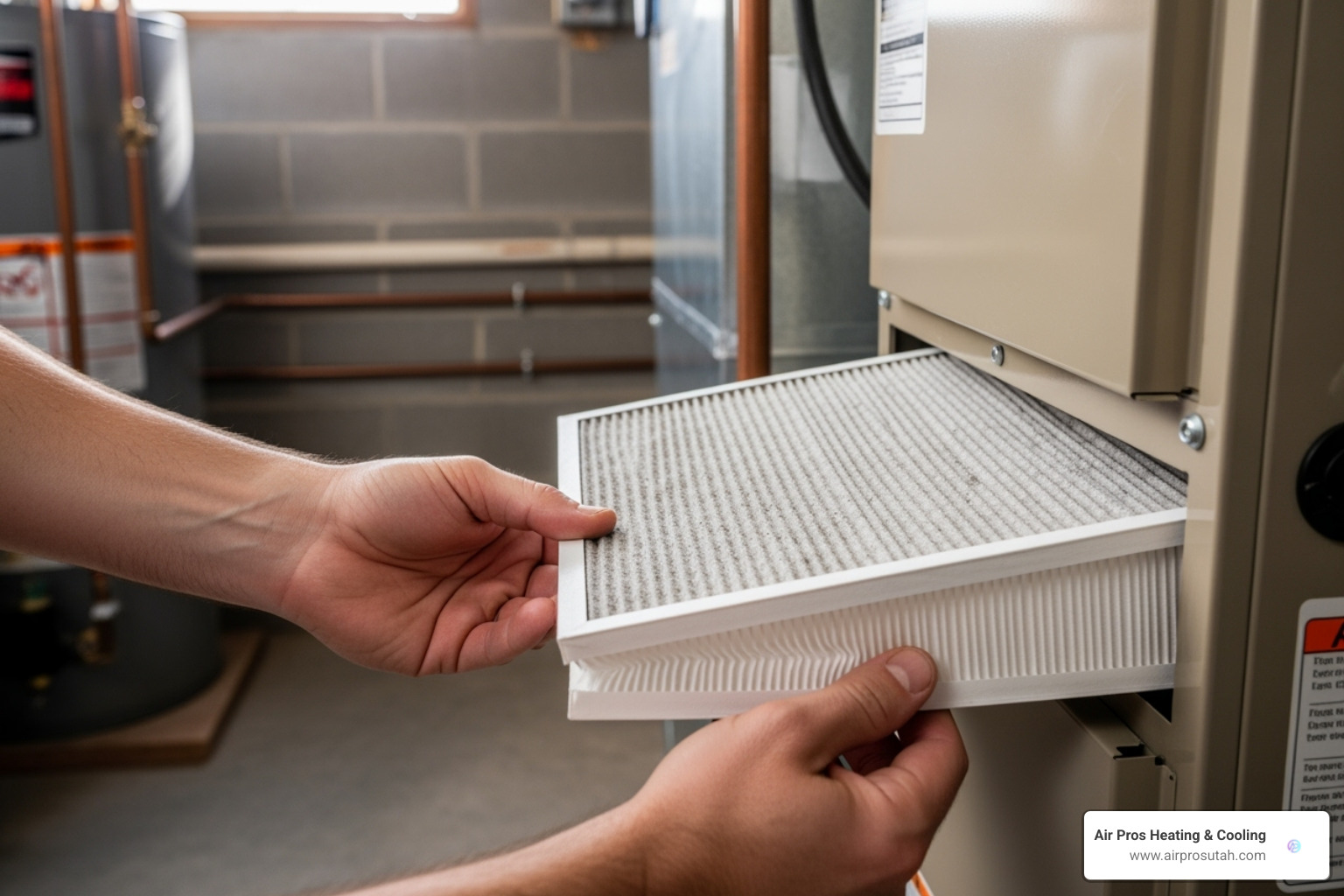
Check your filter monthly—it takes about 30 seconds. If it looks gray or you can't see light through it easily, it's time for a new one. Most homes need a filter change every 1-3 months, but if you have pets or someone with allergies, you might need to change it more often.
Cleaning your outdoor unit is another simple task that pays big dividends. That big metal box outside works hard to release all the heat from inside your home, but it can't do its job if it's buried under leaves, grass clippings, or other debris. Give it some breathing room—clear away anything within two feet of the unit, and gently hose off the fins if they look dirty.
Checking drain lines might sound technical, but it's actually pretty straightforward. Your AC removes humidity from your home, and that water has to go somewhere. If the drain line gets clogged, you might notice water pooling around your indoor unit. A simple mixture of vinegar and water can often clear minor clogs, but if water keeps backing up, it's time to call us.
Scheduling professional tune-ups is where we come in. Even if you're great about filters and keeping things clean, your home air conditioner has internal components that need professional attention. During our annual maintenance visits, we'll clean the coils, check refrigerant levels, inspect electrical connections, and make sure everything is running efficiently. It's like a physical for your AC—we catch small issues before they become expensive problems. Learn more about what we include in our Air Conditioner Maintenance service.
Common Problems and How to Address Them
Even the best-maintained systems can have hiccups. The key is knowing what you can handle yourself and when it's time to call in the experts. Here are the most common issues we see and what you should do about them.
Frozen coils are more common than you'd think, especially during our hot Utah summers when systems work overtime. If you notice ice on your indoor unit or your vents are blowing warm air, turn off your system immediately. Don't try to chip away the ice—let it thaw naturally. Often, frozen coils are caused by restricted airflow from a dirty filter, so check that first. If the problem comes back after you've replaced the filter and let everything thaw, there might be a refrigerant issue that needs professional attention.
Refrigerant leaks are serious business. Your home air conditioner needs just the right amount of refrigerant to work properly, and if it's leaking, you'll notice the cooling power dropping off. You might hear a hissing sound, see unusually high electric bills, or notice that your AC runs constantly but never quite gets cool enough. Refrigerant is not something to mess with yourself—it requires special tools and certification to handle safely.
When your unit won't turn on, start with the simple stuff. Check your thermostat to make sure it's set to "cool" and the temperature is set lower than the current room temperature. Then check your circuit breaker—sometimes a tripped breaker is all that's standing between you and cool air. If those basics don't solve it, you're likely looking at an electrical component issue that needs professional diagnosis.
Strange noises are your AC's way of telling you something's not right. A little humming is normal, but squealing, banging, or grinding sounds mean trouble. Squealing often points to a worn belt or motor bearing, while banging usually means something has come loose. Any unusual sounds warrant a professional look.
Water leaks around your indoor unit usually trace back to that drain line we talked about earlier, or sometimes to frozen coils. If clearing the drain doesn't solve it, or if you're seeing a lot of water, don't wait—water and electrical components don't mix well.
The bottom line is this: when in doubt, give us a call. We'd rather help you with a small issue today than see you dealing with a complete system failure during the hottest week of summer. For urgent situations, we're here for Emergency Air Conditioner Repair to get your comfort back on track quickly.
Frequently Asked Questions about Air Conditioners
Over the years, I've noticed homeowners ask similar questions when they're trying to make the most of their home air conditioner investment. Let me share the answers to the ones that come up most often during our consultations.
How can I save money on my AC energy bills?
This is probably the question I hear most, especially when those summer utility bills start rolling in. The good news? There are plenty of ways to keep your cooling costs under control without sacrificing comfort.
Programmable or smart thermostats are absolute game-changers. The U.S. Department of Energy estimates that homeowners can save as much as 30% on their energy bills by using a programmable thermostat correctly. Set it a few degrees higher when you're away at work, then let it cool things down before you return home. Smart thermostats take this even further—they actually learn your habits and adjust automatically.
Ceiling fans are your home air conditioner's best friend. They don't actually lower the temperature, but they create that nice breeze that makes you feel cooler. This means you can bump your thermostat up from 72°F to 75°F and still feel comfortable, which translates to real savings on your energy bill.
Simple daily habits make a bigger difference than you might think. Close those blinds and curtains during the hottest part of the day, especially on south-facing windows. Skip using the oven on scorching days—fire up the grill outside instead or enjoy some refreshing salads. Your AC won't have to work as hard fighting all that extra heat.
Don't forget about regular maintenance. A well-maintained home air conditioner with clean filters and proper refrigerant levels runs much more efficiently than one that's been neglected. And when you're ready to upgrade, choose an ENERGY STAR certified unit—they use at least 10% less energy than standard models right out of the box.
Should I rent or buy my air conditioner?
This decision really comes down to your personal situation, and honestly, there's no wrong answer—just different paths that work better for different families.
Buying your home air conditioner means you own it outright, which adds value to your home. You can take advantage of manufacturer rebates, special financing offers, and choose exactly which service provider you want for maintenance. The downside? That upfront investment can be substantial—typically $3,995 to $6,000 for a central unit with installation. Plus, once the warranty expires, you're responsible for any repair costs that pop up.
Renting eliminates that big initial expense, giving you predictable monthly payments that make budgeting easier. Most rental agreements include all the manufacturer-recommended maintenance and repairs at no extra cost, which is huge peace of mind. If something breaks at 2 AM on a Sunday, you're covered with 24/7 support. The trade-off is that you don't own the equipment, so it doesn't add to your home's value, and over the long haul, you might pay more than if you'd purchased.
I always tell my customers to think about their comfort level with unexpected expenses and how long they plan to stay in their home. Both options can work beautifully—it's about finding what fits your lifestyle and budget best.
What is R-22 refrigerant and why is it being phased out?
If you have an older home air conditioner (typically installed before 2010), this question probably affects you directly. R-22, commonly called Freon, was the go-to refrigerant for decades, but it has a serious environmental problem.
R-22 is an ozone-depleting substance, meaning it damages the protective ozone layer that shields us from harmful UV radiation. Because of this environmental impact, governments worldwide have been phasing it out. The production and import of R-22 have been banned in many places, and R-22 exacerbates ozone depletion according to environmental regulations.
Modern refrigerants like R-410A and R-32 are much more environmentally friendly. They have virtually no impact on the ozone layer and significantly lower global warming potential. These are what you'll find in today's new AC systems.
Here's what this means for you: if your home air conditioner uses R-22, you're not required to replace it immediately. However, as R-22 becomes scarcer, repairs are getting more expensive. I've seen refrigerant costs skyrocket, making repairs on older units increasingly costly. This is often the tipping point that helps homeowners decide it's time to upgrade to a newer, more efficient system that's better for both their wallet and the environment.
Your Partner for a Cooler Home
Choosing the right home air conditioner doesn't have to feel overwhelming. Throughout this guide, we've walked through everything from system types to maintenance tips, and hopefully, you're feeling more confident about making the best choice for your home.
The variety of cooling options available today means there's truly a perfect fit for every situation. Whether you're drawn to the whole-home comfort of central air, the flexibility of ductless mini-splits, or the simplicity of window units, each type serves its purpose beautifully.
Getting the size right is absolutely crucial – it's the foundation of everything else. An oversized unit will short cycle and waste energy, while an undersized one will struggle to keep up. That's why we always recommend professional sizing rather than guessing based on square footage alone.
Energy efficiency isn't just good for the planet; it's fantastic for your wallet too. High SEER ratings and ENERGY STAR certification translate directly into lower monthly bills. When you combine an efficient home air conditioner with smart features like programmable thermostats, you're looking at potential savings of up to 30% on your energy costs.
Regular maintenance keeps everything running smoothly. Simple tasks like changing filters monthly and keeping your outdoor unit clear of debris go a long way. But don't forget about professional tune-ups – they're like getting a physical for your AC system, catching small issues before they become expensive problems.

At Air Pros Heating & Cooling, we understand that every home in the SLC Valley has unique cooling needs. That's why we focus on delivering personalized solutions rather than one-size-fits-all approaches. Our team takes the time to understand your specific situation, from your home's layout to your family's comfort preferences.
We particularly specialize in ductless mini-split systems because they offer something special – true room-by-room climate control. Imagine being able to keep your bedroom cool for sleeping while not wasting energy cooling unused guest rooms. It's this kind of personalized comfort that makes these systems so appealing to our customers.
Professional installation makes all the difference in how well your home air conditioner performs and how long it lasts. Our experienced technicians serve communities throughout the SLC Valley, including Salt Lake City, Park City, Draper, Sandy, West Jordan, and many others. We believe in clear communication, fair pricing, and building relationships that last well beyond the installation day.
For expert advice on the best cooling solution for your home, especially energy-efficient ductless systems, contact our team for a consultation. We're here to help you stay comfortable all summer long, no matter how intense the Utah heat gets. Learn more about our ductless mini-split systems.


